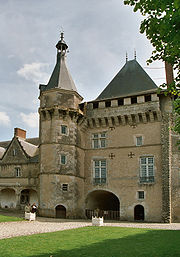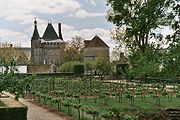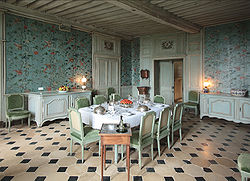
Château de Talcy
Encyclopedia

Loire Valley
The Loire Valley , spanning , is located in the middle stretch of the Loire River in central France. Its area comprises approximately . It is referred to as the Cradle of the French Language, and the Garden of France due to the abundance of vineyards, fruit orchards, and artichoke, asparagus, and...
, famous for its 16th-century châteaux. It was commissioned toward 1520 by Bernardo Salviati
Bernardo Salviati
Bernardo Salviati was an Italian condottiero and Roman Catholic Cardinal.Salviati was born in Florence, the son of Jacopo Salviati and Lucrezia di Lorenzo de' Medici, the sister of Giovanni de' Medici. From an early age he was a knight of the Order of St. John of Jerusalem...
, a Florentine banker with connections to the Medici
Medici
The House of Medici or Famiglia de' Medici was a political dynasty, banking family and later royal house that first began to gather prominence under Cosimo de' Medici in the Republic of Florence during the late 14th century. The family originated in the Mugello region of the Tuscan countryside,...
family. The château, which is imbedded in the village to one side, where the village church forms one side of the courtyard, is more Gothic in its vernacular feeling that might be expected in a structure built for an Italian patron at the height of the Renaissance
Renaissance
The Renaissance was a cultural movement that spanned roughly the 14th to the 17th century, beginning in Italy in the Late Middle Ages and later spreading to the rest of Europe. The term is also used more loosely to refer to the historical era, but since the changes of the Renaissance were not...
.
History
The estate is better known in literary rather than architectural history. Salviati's daughter and granddaughter, Cassandre and Diane, were the muses of two leading French poets of the time, Pierre de RonsardPierre de Ronsard
Pierre de Ronsard was a French poet and "prince of poets" .-Early life:...
and Théodore-Agrippa d'Aubigné, respectively. Ronsard fell in love with the 15-year-old Cassandre in 1552, during his stay at Talcy. He dedicated to her some of the best known sonnet
Sonnet
A sonnet is one of several forms of poetry that originate in Europe, mainly Provence and Italy. A sonnet commonly has 14 lines. The term "sonnet" derives from the Occitan word sonet and the Italian word sonetto, both meaning "little song" or "little sound"...
s in the French language. D'Aubigné, a neighbour of the Salviati, composed for Diane in 1571 the collection of sonnets, ballads, and idylls entitled Le Printemps and at her death the finest of his poems, Les Tragiques.

Catherine de' Medici
Catherine de' Medici was an Italian noblewoman who was Queen consort of France from 1547 until 1559, as the wife of King Henry II of France....
and her son Charles IX
Charles IX of France
Charles IX was King of France, ruling from 1560 until his death. His reign was dominated by the Wars of Religion. He is best known as king at the time of the St. Bartholomew's Day Massacre.-Childhood:...
are said to have planned the Massacre of Saint Bartholomew's Day during the "conference of Talcy" 28 and 29 June 1572.

Philipp Albert Stapfer
Philipp Albert Stapfer was a Swiss politician and philosopher.He was the plenipotentiary envoi of the Helvetic Republic to the French consulate in Paris from 1801 till 1803...
. In 1932 it was sold to the state, on condition that the 18th-century interiors would be preserved intact. The château is visited by 20,000 tourists annually.http://www.ac-orleans-tours.fr/crdp/talcy/dom_talcy/dom_talcy.htm

